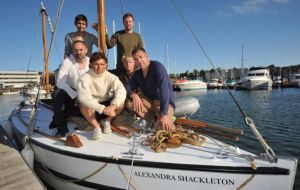MercoPress. South Atlantic News Agency
Recreation of Shackleton 1914 survival epic planned for 20 January
 Tim Jarvis and his team have been planning and practicing for months (Photo AFP)
Tim Jarvis and his team have been planning and practicing for months (Photo AFP) Six British and Australian adventurers are setting off to recreate one of the greatest journeys of human survival. In 1914, Ernest Shackleton, the seasoned British explorer, set out to better Scott and Amundsen by attempting the first-ever crossing of the Antarctic.
But months after embarking and with winter looming, his ship got caught in the ice. Shackleton and his men went onto the ice that would become their home for months.
Their ship slowly sank and so did their ambitions. But as a path cleared through the melting ice, they climbed into a lifeboat and turned to the more pressing mission of survival.
''We're going to do the same, hopefully,'' said the leader of the 2013 Shackleton Epic, Tim Jarvis, a Briton who migrated to Sydney in 1997. Jarvis and his crew are attempting the first recreation of the Shackleton journey, using the same equipment, down to the Gaberdine coats.
Once the ice around them melted, Shackleton and five crew members rowed for 1500 kilometres on a seven-metre boat through the perilous Southern Ocean. Jarvis's crew will row the same route in a replica lifeboat while navigating with sextants.
''This year has been the largest amount of sea ice for 20 years,'' he said. ''Our boat has planking only 1½ centimetre thick.''
The expedition will travel with reserve emergency equipment - satellite phones and beacons - in a sealed box, but otherwise will use equipment from the turn of last century.
A support vessel will trail about 20 nautical miles behind. ''But we have to remember the conditions that are likely to cause us problems are the very same conditions that could prevent it from coming to help us,'' Jarvis said.
The crew has been practising capsizing and sea rowing before their journey; however Jarvis said nothing could really prepare them for the rough and icy seas.
''In sea trials, we had four oars and broke three, but we were given a formula to make them more flexible by soaking them in seawater,'' he said.
They plan to land on the same mountainous fang of rock on South Georgia Island as Shackleton.
When he arrived, the explorer found himself on the wrong side of the island. So he and two other men traversed an icy mountain range before reaching a whaling station on the other side.
Mr Jarvis and crew plan to do the mountain climb while living on animal fat and sleeping for 10 minutes at a time. ''If you stop for longer, you freeze,'' he said.
The crew sails for Antarctica, where they will begin their recreation on January 20, after spending some time trialling their boat in Antarctic seas. Joining the mission is Australian sailor Paul Larsen, who set the world sailing speed record in November.
Larsen said he was awed by the chance to walk in Shackleton footsteps. ''The very essence of adventure is randomness,'' he said. ''Shackleton set out with a plan and something happened and it turned out to be a bigger adventure than he had ever hoped for”.




Top Comments
Disclaimer & comment rulesCommenting for this story is now closed.
If you have a Facebook account, become a fan and comment on our Facebook Page!